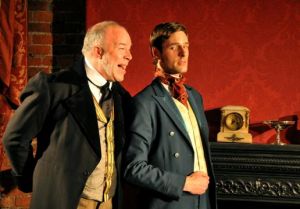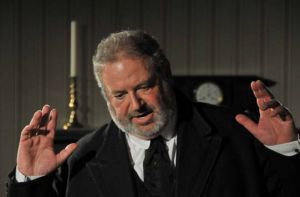Hard Times, Murrays' Mills, Manchester | reviews, news & interviews
Hard Times, Murrays' Mills, Manchester
Hard Times, Murrays' Mills, Manchester
Dickens's industrial novel is staged in an old cotton mill he may have visited
Dickens wasn’t wrong – hard times they were. Around 1300 men, women and children worked at the Murrays’ Mills complex in the Ancoats area of Manchester in its mid-19th-century heyday (if you can call it that). Arrive a minute later than 7am and you were locked out, without pay. Now that actors are treading those same worn and oil-stained boards with an imaginative new version of Hard Times, you won’t get in after 7pm (and you’re the one paying, of course).
In wide bays, where the machines (Dickens’s “mad elephants”) used to clatter and spew out cotton like confetti, on a mill floor 100 metres long and well-suited to a promenade production, are sets for old Gradgrind’s schoolroom, the family drawing room, the posh Bounderby dining room, weaver Stephen Blackpool’s hovel, the bank, Sleary’s circus and the rest.
Manchester Library Theatre’s artistic director, Chris Honer, not only had the brilliant idea to make use of the newly restored mill, whilst his “homeless” theatre waits for its new permanent address, but also to adapt Hard Times. He has assembled a large team and created a dozen sets. In effect, he “shoots” a classic TV serial live. All credit here to designer Judith Croft, Nick Riching (lighting) and Peter Rice (sound) – a tremendous team effort.
The action passes in real time, starting in early evening light through the big windows and ending in darkness, which adds to the atmosphere. Only 80 theatregoers can get in to each of the 23 performances and follow the actors from set to set, from schoolroom to, finally, the circus. It is a memorable theatrical experience to be so close to the action; I literally felt an actor breathing down my neck.
 There is a danger that the novel, with all its messages about family dysfunction, narrow-minded education, capitalism and trade unionism, might get overtaken by the excitement of the event. But Charles Way’s adaptation at nearly three hours fluently conveys the humanity, the warmth and the bitterness of the original in which strict educationist Thomas Gradgrind ("facts facts facts!") pursues his rigid approach to education. His own children, Louisa and Tom, are repressed even at home, but when he adopts Sissy Jupe, the daughter of a circus clown, he meets his match - she is bred on imagination and wonder.
There is a danger that the novel, with all its messages about family dysfunction, narrow-minded education, capitalism and trade unionism, might get overtaken by the excitement of the event. But Charles Way’s adaptation at nearly three hours fluently conveys the humanity, the warmth and the bitterness of the original in which strict educationist Thomas Gradgrind ("facts facts facts!") pursues his rigid approach to education. His own children, Louisa and Tom, are repressed even at home, but when he adopts Sissy Jupe, the daughter of a circus clown, he meets his match - she is bred on imagination and wonder.
Alice O’Connell as Louisa, led into a loveless marriage to the bullying old mill owner, Josiah Bounderby, and Verity May Henry as Sissy, play beautifully off each other – the one cold until she eventually confronts her father, the other loving and loyal. (Pictured above: Richard Heap as Bounderby and Richard Hand as Harthouse.) Meanwhile, the factory’s “hands” – “they expect turtle soup and venison eaten with a gold spoon”, repeats Bounderby – are pressured to become unionised. One honest weaver, Stephen Blackpool, resists, is sent to Coventry and is later sacked by Bounderby for expressing loyalty to his loved one rather than his boss.
 There’s a cast of 11, several multitasking for Dickens’s 22 characters, backed up by a local community group of around 20. Notable performances come from David Fleeshman (pictured left) as a misguided rather than dictatorial Gradgrind and Richard Heap as the blustering industrialist Bounderby. And then there’s the circus – well, a couple of acrobats, directed by Mish Weaver of Stumble danceCircus, who close the show on a high note (not wire). It is a bright, jolly and colourful way to end an evening that begins in the dark and dusty underground hovels, where you rub shoulders with downtrodden workers and unspecified spooky characters. A bit like entering the ghost train, but more serious.
There’s a cast of 11, several multitasking for Dickens’s 22 characters, backed up by a local community group of around 20. Notable performances come from David Fleeshman (pictured left) as a misguided rather than dictatorial Gradgrind and Richard Heap as the blustering industrialist Bounderby. And then there’s the circus – well, a couple of acrobats, directed by Mish Weaver of Stumble danceCircus, who close the show on a high note (not wire). It is a bright, jolly and colourful way to end an evening that begins in the dark and dusty underground hovels, where you rub shoulders with downtrodden workers and unspecified spooky characters. A bit like entering the ghost train, but more serious.
Modest background music by Colin Sell, of Radio 4’s I’m Sorry I Haven’t a Clue fame, largely pre-recorded with his acoustic instrumental players from East 15 School in London (where he is head of music), aims to recapture something of the relentless rumble of the machines, as well as supplying period hymns, popular songs of the day and circus noises.
There is every chance that Dickens saw the place for himself on one of his many visits to Manchester factories, when Murrays’ was an industrial showplace attracting international visitors. And by the time he finished his novel in 1854, after serialisation in his weekly periodical Household Words, the “golden age” of the textile industry was just beginning. There were 2,650 textile mills in Lancashire, employing 440,000 people. After a £10 million restoration of Murrays’, now rearing up in all its original red-brick architectural glory, adjacent to the still-black Rochdale Canal and the rubble on the other side, Hard Times has come home.
Share this article
more Theatre
 London Tide, National Theatre review - haunting moody river blues
New play-with-songs version of Dickens’s 'Our Mutual Friend' is a panoramic Victori-noir
London Tide, National Theatre review - haunting moody river blues
New play-with-songs version of Dickens’s 'Our Mutual Friend' is a panoramic Victori-noir
 Machinal, The Old Vic review - note-perfect pity and terror
Sophie Treadwell's 1928 hard hitter gets full musical and choreographic treatment
Machinal, The Old Vic review - note-perfect pity and terror
Sophie Treadwell's 1928 hard hitter gets full musical and choreographic treatment
 An Actor Convalescing in Devon, Hampstead Theatre review - old school actor tells old school stories
Fact emerges skilfully repackaged as fiction in an affecting solo show by Richard Nelson
An Actor Convalescing in Devon, Hampstead Theatre review - old school actor tells old school stories
Fact emerges skilfully repackaged as fiction in an affecting solo show by Richard Nelson
 The Comeuppance, Almeida Theatre review - remembering high-school high jinks
Latest from American penman Branden Jacobs-Jenkins is less than the sum of its parts
The Comeuppance, Almeida Theatre review - remembering high-school high jinks
Latest from American penman Branden Jacobs-Jenkins is less than the sum of its parts
 Richard, My Richard, Theatre Royal Bury St Edmund's review - too much history, not enough drama
Philippa Gregory’s first play tries to exonerate Richard III, with mixed results
Richard, My Richard, Theatre Royal Bury St Edmund's review - too much history, not enough drama
Philippa Gregory’s first play tries to exonerate Richard III, with mixed results
 Player Kings, Noel Coward Theatre review - inventive showcase for a peerless theatrical knight
Ian McKellen's Falstaff thrives in Robert Icke's entertaining remix of the Henry IV plays
Player Kings, Noel Coward Theatre review - inventive showcase for a peerless theatrical knight
Ian McKellen's Falstaff thrives in Robert Icke's entertaining remix of the Henry IV plays
 Cassie and the Lights, Southwark Playhouse review - powerful, affecting, beautifully acted tale of three sisters in care
Heart-rending chronicle of difficult, damaged lives that refuses to provide glib answers
Cassie and the Lights, Southwark Playhouse review - powerful, affecting, beautifully acted tale of three sisters in care
Heart-rending chronicle of difficult, damaged lives that refuses to provide glib answers
 Gunter, Royal Court review - jolly tale of witchcraft and misogyny
A five-women team spell out a feminist message with humour and strong singing
Gunter, Royal Court review - jolly tale of witchcraft and misogyny
A five-women team spell out a feminist message with humour and strong singing
 First Person: actor Paul Jesson on survival, strength, and the healing potential of art
Olivier Award-winner explains how Richard Nelson came to write a solo play for him
First Person: actor Paul Jesson on survival, strength, and the healing potential of art
Olivier Award-winner explains how Richard Nelson came to write a solo play for him
 Underdog: the Other, Other Brontë, National Theatre review - enjoyably comic if caricatured sibling rivalry
Gemma Whelan discovers a mean streak under Charlotte's respectable bonnet
Underdog: the Other, Other Brontë, National Theatre review - enjoyably comic if caricatured sibling rivalry
Gemma Whelan discovers a mean streak under Charlotte's respectable bonnet
 Long Day's Journey Into Night, Wyndham's Theatre review - O'Neill masterwork is once again driven by its Mary
Patricia Clarkson powers the latest iteration of this great, grievous American drama
Long Day's Journey Into Night, Wyndham's Theatre review - O'Neill masterwork is once again driven by its Mary
Patricia Clarkson powers the latest iteration of this great, grievous American drama
 Opening Night, Gielgud Theatre review - brave, yes, but also misguided and bizarre
Sheridan Smith gives it her all against near-impossible odds
Opening Night, Gielgud Theatre review - brave, yes, but also misguided and bizarre
Sheridan Smith gives it her all against near-impossible odds

Add comment